An analysis of history on TV, the internet and social media in the Netherlands: 2016 and 2017
Second update
Updates
2016 (web) | 2016 (tv) | 2017 | 2018
Written by Laura Steenbrink and Rivka Otten
Edited by Steven Stegers
Introduction
This analysis is part of the project “Media and History. From cinema to the web. Studying, representing and teaching European history in the digital age”, coordinated by Instituto per la Storia e le Memorie del ‘900 Parri. This analysis has been created by Laura Steenbrink, with contributions of Rick Hoefsloot, Bjorn Pels, Joyce Schäftlein, Romana Sijakovic, Suzanne Tromp, Shanice de Witte, and Steven Stegers.
The analysis gives an impression of how history is represented on television and on the internet in The Netherlands over the course of two years. The analysis consists of an overview of the general offer of history on television in the Netherlands, a description of historically significant days for the Netherlands, a comparison between the history programs and of the posts on social media on these historically significant days, and a comparison between the news broadcasts on the National Remembrance Day and Europe Day.
Matching analysis for Hungary, Italy, Poland, Spain and the United Kingdom are available at http://www.e-story.eu/observatory/. For the analysis of 2017, the team members from these countries agreed that they would all focus their analysis on the same week: 1 to 7 May 2017, so that the results allow for comparison. The analysis is made possible with the support of the Erasmus+ program of the European Union.
-
History Outside of the Classroom
Learning about history is not only taking place in schools. Students are exposed to it in various ways. Movies, books, documentaries, games, magazines, news, family stories, and social media all influence how students look at history. Due to the increased digitisation of society, young Europeans are increasingly see historical information or historical representations in the form of digital media. In the “Media and History” project – of which this observatory is a part – specialists in history and media education from Hungary, Italy, Poland, Slovenia, Spain, The Netherlands and United Kingdom work together to encourage history educators to use multimedia resources to help students become more media literate.
The goal of this observatory is to map out the TV offer and social media posts concerning history in the Netherlands, in order to see what the content of the current offer is. It will cover the historical content on TV during a typical week, and take a more in-depth look at historically significant days. The results of this analysis show how this subject is approached by the media, where their focus lies and how they convey their message. In terms of the project of “Media and History” the findings of this observatory are important, because it highlights what the current status of history on TV and social media is, and thereby how it can potentially influence the way students look at history.
-
The TV offer – A general impression of the offer of history television and the internet in 2016 and 2017
In the Netherlands, everybody with access to television has access to the public channels, NPO1, NPO2, and NPO3.[1] Most people with access to TV also have access to a large variety of commercial TV channels, of which RTL is the biggest and most watched.[2] The public channels are freely accessible for everyone via the internet.[3] The programs of the public network are co-financed by the general taxes. The commercial channels are part of a package deal, and only available to paid customers of TV providers such as Ziggo, UPC and KPN.
The main history offer in the Netherlands consists of history documentaries that are produced in the Netherlands, co-funded by public money, and broadcasted on public channels. In addition, there are international productions, consisting of historical movies (mostly blockbusters from Hollywood), and some history documentaries.
The most important and well-known history program is Andere Tijden (different times), which has been broadcasted since 10 March 2000.[4] This weekly show, which is every year broadcasted during several months, covers a large variety of Dutch historical events and developments, looking at social, cultural, economic history as well as political and military history. In a typical episode, the presenter, who is also a historian, introduces a topic and goes on a quest to find more information. This information is then provided through interviews with experts and eyewitnesses (both ordinary people and decision makers), and complemented with original footage and voice over (by the presenter). During large sport events, the show transform itself into Andere Tijden Sport, in which it then covers the stories behind historical sport moments in the Dutch collective memory.
In addition to Andere Tijden, several history documentaries focused on Dutch history have been produced. These documentaries focused on topics such as ‘The Golden century’[5], ‘The Iron century’[6], ‘Slavery’[7], and ‘Liberation’[8]. These large productions have dealt with different aspects of Dutch national history, from the so-called golden age (17th Century), to the Dutch slave trade, to the industrial revolution, to the Second World War.
To mark the 200-year anniversary of the Kingdom of the Netherlands, several programs were made about on history of the royal family. These were Het koninkrijk (the Kingdom)[9], Drie Vorstinnen (Three Queens)[10], and Drie Koningen (Three Kings)[11].
In 2017, a new historical documentary miniseries, also produced by the team that made Andere Tijden, aired on NPO 2. Goede Hoop (Good Hope)[12], looked into what the Dutch influence on South African history has been, from the Dutch East India Company until the end of Apartheid. It is still a documentary very much focused on Dutch national history, but does in a sense diverge from the traditional format of a Dutch history documentary. Firstly it is centered on South African history, and not solely focused on Dutch national history, and secondly it extends much further than TV only. The series aired in seven instalments in March 2017, and was among others, complemented by a book, an exposition in the Rijksmuseum in Amsterdam, a crossover with the Dutch children’s program Klokhuis, and a Spotify playlist.
The history documentaries produced in the Netherlands tend to focus on national history, but there has been one notable exception: the documentary series In Europa, (in Europe).[13] This program was based on the book by the same name written by the Dutch historian Geert Mak, who also presents the TV program. It covers the whole of the European history in the twentieth century, for which Mak travels throughout Europe and interviews eyewitnesses and relatives of historical events, and also visits places of memory. The ‘In Europe’ TV series received wide critical acclaim and has been broadcasted in other countries as well.
There was a digital national history channel (that subscribers to cable television could access), which broadcasted the programs mentioned above and special feature programs. However, this digital channel has not been available since 2012. Most programs can now be seen on online on either http://www.npo.nl/ or http://anderetijden.nl/.
In the last decade, several commercial movie productions focused on history. This trend started with the movie Zwartboek (Black Book) that was produced in 2006 and is to date the most expensive movie produced in the Netherlands of all time, and which was a commercial success.[14] Zwartboek tells the story of a Jewish woman during the Second World War, who attempts to evade deportation, to help the resistance, and who has a relationship with an SS officer. One historian, J.C.H. Blom, wrote in his review, that although he found Zwartboek to be a good movie, viewers should not take the phrase ‘inspired by true events’ too literal. [15] In terms of popular culture, the focus of Zwartboek on the Second World War, and the Dutch resistance in particular, fits in a longer tradition. Especially in the field of literature, the Second World War has been by far the most common history topic.
A more recent example of a commercial movie produced in the Netherlands and focussed on history is Michiel de Ruyter (published in English under the title ‘The Admiral’ in 2015)[16]. This movie is about Michiel de Ruyter, who is most known for the navel battles he fought against the British in the 17th Century. The release Michiel de Ruyter triggered a protest by a group that called Michiel de Rover (Rover means robber, and is a play on words, see Image 1). This group found it problematic that no attention was given in the movie to slavery. This triggered further debate amongst historians, some of whom argued that Michiel de Ruyter should be judged in the context of his time, and some of whom argued that he did conquer back forts that were enabled slavery to take place.[17] The debate was also pick up by some media, including radio, typically asking viewers for their opinions.
![Image 1. Cover of the Michiel de Rover Facebook page. The text in red says “Michiel the Robber is not my hero”. The text in yellow reads: Don’t honour De Ruyter, honour the resistance against slavery instead! Away with the VOC mentality![18] Stop glorifying racism and colonialism!](http://www.e-story.eu/wp-content/uploads/2017/11/ned1-copy.jpg)
Image 1. Cover of the Michiel de Rover Facebook page. The text in red says “Michiel the Robber is not my hero”. The text in yellow reads: Don’t honour De Ruyter, honour the resistance against slavery instead! Away with the VOC mentality![18] Stop glorifying racism and colonialism!
-
History on TV during a “typical week” in 2016
To give an impression of the history offer on TV, the project team agreed to look, in 2016, in more detail at a typical week of TV. This means that there should be no holidays or national remembrance days during this week. For our analysis, we analysed the programs that were on offer from 17 June to 23 June 2016.
All TV programs that were broadcasted during this week that related to history were broadcasted on one of the national, financed by public money, non-commercial, public channels. During this week, there were 6 programs broadcasted related to history. Four of these programs were part of a documentary type series, called De Strijd (“The Battle”) describing the emergence of the labour movement in the Netherlands. The other history related offer consisted of a movie, The Young Victoria[22], an anglo-american production about the early life of Queen Victoria (ruler of the United Kingdom from 1837 – 1901), and one other documentary called Drie Vorstinnen van Oranje (“Three female sovereigns of Orange”) that is part of a series. The episode this week focused on Queen Wilhelmina (of the Netherlands from 1890 – 1948).
Except one movie, all history related programs are documentaries. The topics are related to the history of the 19th and 20th century. None of the programs focuses on one specific event, as many programs highlight a broader theme, rather than a specific historical moment. The people that account for the past in the programs vary from witnesses, to voiceovers, actors to historians. Almost all programs that we presented where analytical in the senses that the topic or issue of the documentary is looked at from different perspectives. With the exception of the Young Victoria movie, all programs broadcasted this week, were co-financed with public money. This could imply that not many commercial channels think it would be profitable to broadcast or produce programs that are related to history. Finally, the viewing statistics are relatively low. The history programs had between 50.000 and 311.000 viewers (for Drie Vorstinnen van Oranje). An overview of the complete history offer during this week can be found in Table 1 below.
Table 1. The history offer on TV during a “typical week”
| Number of viewers | Name of the program | Time and Date | Channel | Type | Who accounts for the past | Approach[23] |
| 311,000 | Drie Vorstinnen van Oranje | 18 June 2016,
19:35 – 20:15 |
NPO 1 | Documentary | Historian(s) | Analytical |
| 144,000 | Young Victoria | 17 June 2016,
23:40 – 01:30 |
NPO 2 | Film | Actors | Emotional |
| 113,000 | De Strijd: De Gouden Eeuw van de Arbeider | 20 June 2016,
16:08 – 17:00 |
NPO 2 | Documentary | Witness(es) | Thematic |
| 59,000 | De Strijd: De Gouden Eeuw van de Arbeider | 17 June 2016,
16:10 – 16:55 |
NPO 2 | Documentary | Witness(es), Voice-over/presenter, Socialists | Analytical |
| 59,000 | De Strijd: De Gouden Eeuw van de Arbeider | 21 June 2016,
16:05 – 16:50 |
NPO 2 | Documentary | Witness(es), Voice-over/presenter | Analytical |
| 50,000 | De Strijd: De Gouden Eeuw van de Arbeider | 22 June 2016,
16:10 – 16:55 |
NPO 2 | Documentary | Voice-over/presenter, Politician | Analytical |
A “typical week” of TV on the History Channel
In the Netherlands, there is no national channel completely related to history. There is an online channel that is part of the public channel NPO 2, but that channel is not completely devoted to history. The TV programs on NPO 2 that are related to history are already described in the section above. Almost all packages have the American History channel, but we decided not to research that here because it does not represent the offer of history on Dutch television.
4. The most popular TV program related to history in 2016 and 2017
The most watched TV program related to history, as proved by the viewing statistics provided by Stichting Kijkonderzoek[24], the organization that does research to the viewing statistics in the Netherlands, is De Gouden Eeuw (The Golden Age, see the more in-depth description below). The complete season of De Gouden Eeuw had an average of 774.000 viewers per week.[25] The series was broadcasted from 11 December 2012 – 5 March 2013 on NPO2, one of the public channels.
The second most watched TV program related to history is Verborgen Verleden. It had an average of around 600.000 viewers every week.[26] This program is – as of 2017 in its seventh season -still running and is based on the format of “Who do you think you are”, the British TV program where celebrities go on a trip to find out interesting stories about the origins of their family.
De Gouden Eeuw
“De Gouden Eeuw” is a documentary type TV program that was broadcasted in a series of 13 episodes in 2012 and 2013. It presents the so-called the Dutch Golden Age, a period of economical bloom in the 17th and 18th century in the Netherlands. In thirteen episodes, various aspects of this era are highlighted. For example, the uprising against the Spaniards during the Eighty Years’ War, the parliamentary history, the Dutch East Indian Company (Verenigde Oost-Indische Compagnie, VOC), the economic, social and art history are covered in the different episodes.
In the TV series, the historical context and explanations are given by three types of people: the voice-over, the presenter (who is also a historian) and various historians. These historians are often interviewed by the presenter, on the local sites, often on the exact spot where the historical event that are being talked about happened.
The makers of the series create a link with the present in every episode. This makes the program more appealing to a larger public and to explain the relevance of history for today. The approach is analytical in the sense that different historical interpretations are being explored and multiple aspects of a historical topic or development are highlight. For example, the fifth episode which is looking at the history of the VOC mentions and gives attention to different aspects of the VOC, some of which are good, and some of which are bad.
The series was made as a reaction to a statement made by the Prime Minister of the Netherlands in 2006, Jan Peter Balkenende, who said: “Let’s be happy with each other! Let’s say: the Netherlands can do it again! That VOC-mentality, watching over boundaries, dynamics! Right?”[27] This statement received critical attention and many were angry about the way the Prime Minister used the VOC in a positive, while the VOC is also known for its oppressive methods and engaging in slave trade. The presenter of the series, Hans Goedkoop, explained their motivation for the series, in reaction to the debate triggered by Jan Peter Balkenende’s statement: “In the Netherlands we think quickly that it is too chauvinistic to devote too much attention to the Golden Age. If we give it attention, we are inclined to emphasise the bad side. But foreign historians praise the period as the beginning of world trade.”[28] Hans Goedkoop also mention the dark side of the period, but in this statement, it seems a reaction to bring more perspective into the debate whether or not the period of the Golden Age deserves its name.
In sum, the history offer on TV in the Netherlands consists mainly of history documentaries focussed on different aspects of national history, made with the support of the government. There are also commercial movies related to national history, reaching different audiences, typically focussed national heroes. There is little attention for history that is not directly related to the history of the Netherlands.
-
Historically significant days
There are several National Remembrance Days in The Netherlands. For this analysis, we focused on the National 4 and 5 May Remembrance Day (commemorating the end of World War 2 for the Netherlands), the National 1 July Remembrance Day (commemorating the abolition of slavery in Surinam and the Antilles, who were then Dutch colonies), and Europe Day, commemorating and celebrating peace and unity in Europe on 9 May.
These days are specifically important to the Netherlands, because they represent issues that are still sensitive to this day.
5.1 Remembrance days in the Netherlands
The 4 May Remembrance Day commemorates the all Dutch victims of war since the beginning of the Second World War.[29] The 4 May commemoration includes a national remembrance ceremony that takes place every year in Amsterdam at Dam Square. Everybody in the country is asked to pay respect by holding a two-minute silence at 20:00. The 5 May Remembrance Day commemorates the liberation of the Netherlands from Nazi German occupation in 1945. 5 May is a public holiday every five years but in 2016 it coincidentally was together with Accession Day, so it was a public holiday in that year as well. 5 May is being celebrated through a series of festivals and concerts across the country. A national concert is held on a canal in Amsterdam, attended by several members of the royal family. Both 4 and 5 May Remembrance Days are being organised by the National Committee 4 and 5 May, a foundation funded by the government.[30]
5.1.1 Remembrance days in the Netherlands on TV in 2016
On 4 May 2016, twelve programs paid attention to the Remembrance Day for at least part of the program, of which eight programs were broadcasted especially for the occasion of the Remembrance Day. The offer consisted of three daily talk shows, one news broadcast, two reportages of remembrance ceremonies, four documentary type programs and three theatre related programs. In addition to this, several movies related to the history of the Second World War, such as Schindler’s List and The Boy in the Striped Pyjamas were broadcasted on commercial channels. Of the twelve programs described above, the best viewed program was the national remembrance ceremony, which was viewed by 2.560.000 people.[31] The most viewed TV documentary type program on the National Remembrance Day, viewed by 810,000 viewers, was ‘De Onderduikkinderen van Utrecht’ broadcasted on NPO2, one of the public channels, from 20:30 – 21:00 (see more in-depth description below).
On several programs, the discussion #geen4meivoormij/#wel4meivoormij that is described in the analysis of social media is mentioned. Most programs adopt an emotional approach and focus on remembrance as main theme of the program (see
Table 2). One documentary has an analytical approach, showing not only the story of the victims, but also of the helpers and the view of a historian are taken in account. One talk show also has an analytical approach, enabling multiple people explain their experience and give their opinion and insight into the topic of anti-Semitism. Although most of them are Jewish, they do have multiple perspectives on various topics, for example about the meaning of their religion nowadays. Some of them also approach the topic in a multiperspective and analytical way and bring nuance to the discussion. An overview of the complete offer of programs related to the victims of World War 2 and other can be seen in
Table 2 below.
Table 2. The history offer on TV related to 4 May Remembrance Day 2016
| Number of viewers | Name of the program | Time and Date | Channel | Type | Who accounts for the past | Approach[32] |
| 2,560,000 | Nationale Herdenking 2016 | 4 May 2016, 19:30 – 20:10 | NPO 1 | Reportage | Well-known individual(s), Voice-over/presenter, Civilians | Descriptive and emotional |
| 1,117,000 | De Wereld Draait Door | 4 May 2016, 19:00-20:00 | NPO 1 | Talkshow | Well-known individual(s), Journalist(s), Witness(es) | Emotional |
| 992,000 | News Broadcast of the National Broadcast Foundation of the Netherlands | 4 May 2016, 18:00 – 18:25 | NPO 1 | News | Journalist(s), Voice-over/presenter, Museum Staff | Emotional |
| 810,000 | De Onderduikkinderen van Utrecht | 4 May 2016, 20:30-21:00 | NPO 2 | Documentary | Historian(s), Witness(es) | Analytical |
| 863,000 | Dodenherdenking Waalsdorpervlakte | 4 May 2016, 19:49-20:10 | RTL 4 | Reportage | Witness(es), Voice-over/presenter | Emotional |
| 718,000 | RTL Late Night | 4 May 2016, 22:30 – 23:40 | RTL 4 | Talkshow | Witness(es) | Emotional |
| 659,000 | Pauw | 4 May 2016, 22:45-23:45 | NPO 1 | Talkshow | Well-known individual(s), Journalist(s), Author(s), rabbi | Analytical |
| 610,000 | Andere Tijden Special: De laatste verzetsstrijders | 4 May 2016 – 21:00-22:00 | NPO 2 | Documentary | Witness(es) | Emotional |
| 341,000 | NOS Vuur van de Vrijheid | 4 May 2016, 00:30-01:10 | NPO 1 | Theater show | Voice-over/presenter | Emotional |
| 197,000 | Maliebaanmonologen | 4 May 2016, 22:45-23:05 | NPO 2 | monologue | Actor | Emotional |
| 146,000 | Debby Petter: Ik ben er nog | 4 May 2016, 23:05 – 23:55 | NPO 2 | Theatre performance | Actress performing the witness story of her mother | Emotional |
| 111,000 | NOS Jules Schelvis (extra broadcast) | 4 May 2016, 16:12-16:38 | NPO 1 | Documentary | Historian(s), Journalist(s), Witness(es) | Thematic and emotional |
De Onderduikkinderen van Utrecht
This documentary tells the story of Frits Pront, who is researching his own past. He survived the war with the help of the Utrechts Kindercommittee (Child Committee of Utrecht). The Kindercommittee was a group students in the city of Utrecht who helped Jewish children to go underground during World War 2. During the war, several Razzia’s were held. These were large scale raids to find enemies of the regime, in this case mainly Jewish people. A student from Utrecht saw the razzia’s and the often very young children who had just lost their parents in these razzia’s together with other student helped these Jewish children. Contacts in Amsterdam at the time of the war, advised Jewish parents to let their children underground in Utrecht. The documentary explained that the students did not saw the danger of their work because they thought that helping children ways is good. Several children were betrayed however.
The documentary makes clear that the people who were helping victims to go underground were not always nice, and that being underground was not always happy. Pront was abused physically and mentally. Another child rescued by the Kindercommittee, Frank, had to stay with her helpers after the war for a while as Frank’s parents did not come back. The documentary also pays attention to the tough choices that the Kindercommittee had to make. This was the case when one of the houses where children were placed turned out to be the house of traitors. The Kindercommittee, when they found out, wanted to liquidate these traitors, but their attempt to do so, failed for the most part, leading to the betrayal of the Kindercommittee. In the end 350 children were saved.
The documentary provides the historical context in which the Kindercommittee worked by explaining that the NSB, a Dutch party loyal to the Nazi’s, had their headquarters in Utrecht, that many loyalists lived there as well, and that several students were radicalising, all prosing great dangers for the work of the Kindercommittee. Original historical footage from the World War 2 is used to help the viewers imagine the past. It is not evident how far the historical footage is matching the events that are being discussed. In addition, new footage with reconstructions of the past was used to support the story. The documentary makes a link with the refugees of today, when Pront points out how terrible it for children to be forced to more from place to place every time again.Making a documentary is very difficult and possibly underestimated. Finding a balance in facts and emotions plus showing images really suitable to the theme without a misrepresentation is a hard job. By showing the achievements, but also the limitations, the difficulties, and the bigger picture, this documentary came a long way in providing a balanced view.
On 5 May, there were eight programs that were either completely or partially related to the liberation of the Netherlands. We analysed three talk shows, one news reel, one documentary type program and four other programs. These other programs were broadcasted only on this day so were not part of a series. They were all focused on how the day is celebrated in the Netherlands. The most watched program of these was the national news broadcasted at 20.00 (viewed by 1,777,000). The most watched TV documentary type program related to the end of WW2 was Maliebaanmonologen, broadcasted on NPO2, one of the public channels from 22:45-23:00 (see more in-depth information below).
Almost all programs are more dedicated to how people are celebrating Liberation Day, than on the actual history. Not all talk shows dedicated their whole show to the liberation, for example De Wereld Draait Door was more focused on the 21st century than the Second World War. The news broadcasts made only one historical reference when it showed a temporary monument that was made in Amsterdam in the form of a bridge crossing the IJ remembering the so-called Hunger Bridge of 1945 made of ferries that had run out of fuel to connect the Northern part of Amsterdam with the rest of Amsterdam to bring enable the transport of food.[33] The rest of the item addressing the liberation, solely focussed on all the festivals and events that happened throughout the Netherlands. The only program that was broadcasted on a commercial channel (RTL Late Night) and mentioned Liberation Day, made no historical reference at all. One-fifth of the talk show was dedicated to Liberation Day, and only touched upon the concept of freedom without historical references being made. An overview of the complete offer of programs related to the Liberation of the Netherlands in 1945 can be seen in
Table 3 below.
Table 3. The history offer on TV related to 5 May Remembrance Day
| Number of viewers | Name of the program | Time and Date | Channel | Type | Who accounts for the past | Approach[34] |
| 1,777,000 | NOS Journaal | 5 May 2016, 20:00 – 20:25 | NPO 1 | News | Journalist(s), Voice-over/presenter | Thematic |
| 1,548,000 | NOS Bevrijdingsdag: Concert op de Amstel | 5 May 2016, 20:20 – 22:05 | NPO 1 | Concert | Well-known individual(s), Journalist(s), Author(s), Witness(es) | Thematic |
| 898,000 | RTL Late Night | 5 May 2016, 22:30 – 23:40 | RTL 4 | Talkshow | Musicians | Emotional |
| 882,000 | De Wereld Draait Door | 5 May 2016, 19:00 – 20:00 | NPO 1 | Talkshow | Historian(s), Well-known individual(s), Journalist(s) | Analytical |
| 231,000 | Nationale viering bevrijding 2016 | 5 May 2016, 11:00 – 12:00 | NPO 1 | Both lecture and talkshow | Journalist(s), Witness(es), Voice-over/presenter | Analytical |
| 163,000 | Pauw | 5 May 2016, 22:50 – 23:40 | NPO 1 | Talkshow | Well-known individual(s), Author(s) | Emotional |
| 106,000 | NOS Artiesten voor de Vrijheid 2016 | 5 May 2016, 23:25 – 23:50 | NPO 3 | Reportage | Voice-over/presenter | Thematic |
Maliebaanmonologen
Last year, it was exactly 70 years ago that the Second World War ended and the Netherlands was freed from German rule. To give this celebration extra attention, a local theatre group in Utrecht, made six short plays, monologues, about life under German rule in Utrecht. These monologues were filmed and broadcasted this year in the week of 4 and 5 May.
For six days in a row, the NPO (Dutch Public Broadcasting) aired one episode of the Maliebaanmologen, that together tell the story of the Maliebaan in Utrecht, which they claim was ‘most exiting street in the Netherlands during World War 2: the. Each episode, one actor plays a monologue of a person working or living at the Maliebaan during World War Two. The monologues are all based on the book ‘Aan de Maliebaan’, written by Ad van Liempt.
During the Second World War, the Maliebaan hosted more than 10 German institutions and at least as many NSB related offices. At the same time, this street was also still the living place of many normal people and some resistance fighters. This makes it an interesting street where many things happened even though it looked like a decent and quite street.
The episode aired on 5 may 2016, tells the story of Marie Anne Telegen, a resistance fighter who lived at Maliebaan 72Bis, next to the German Sicherheitspolizei (Security Service), during the year so the war. The actress who is playing Marie Anne Telegen, is the main story teller. She tells how her character worked for the municipality, and arranged and spread the wages of the railway personnel during the National Railway Strike in 1944 in her free time. She explained that his was a dangerous job, that she recruited women called ‘Koeriersters’ to pick up the money and deliver it to different addresses where people from the Railway Company were hiding for the Germans.
This approach of letting one person act and play the story of a real person living in Utrecht during World War Two is emotional. The viewers are drawn into the life of Marie Anne Telegen, and helped to image what the past has been like. The fact that each story is only 15 minutes, and the fact that multiple stories are told, enables the audience to learn about history in an interesting and effective way.
5.1.2 Remembrance days in the Netherlands on Social Media in 2016
This part of the analysis focuses on the social media coverage of history related to the 4 and 5 May National Remembrance Days in The Netherlands in 2016.[35] The analysis is based on all Twitter and Facebook posts using the hashtags #4mei (4May), #dodenherdenking (Remembrance Day), #geen4meivoormij (No 4 May for Me) and #wel4meivoormij (4 May for Me). These were the hashtags that were trending and related to the National Remembrance Days just before, during, and just after 4 May and 5 May in 2016.
#Geen4meivoormij: In 2016, the National Remembrance Day of 4 May in the Netherlands became a topic for debate when a Facebook post by Christa Noëlla, a 22-year old woman from the Netherlands, went viral, and triggered many positive and negative reactions.[36] In the post (see image 1) you can see her holding a paper with the text “Geen 4 mei voor mij” (No 4 May for me). In her post Christa argued that National Remembrance Day should become more inclusive and remember a wider range of victims, in particular the victims from Dutch slavery through the centuries and argued that she found the commemoration meaningless in the face of the rise of fascism and islamophobia. The full texts is included as Annex 1. In an interview with NRC Newspaper, Christa Noëlla is quoted explaining her background: “My father is Suriname-Javanese. My grandparents were shipped to Surinam in 1930 to do the work that was previously done by enslaved people. I have a Dutch mother whose grandparents were in hiding during the Second World War”.[37]
#wel4meivoormij: The counter reaction that got most attention, was a Facebook post by Brian, a 36-year-old vocalist and songwriter, who introduced the hashtag #wel4meivoormij (4 May for me) (see Image 1). The post by Christa Noëlla, the reaction of Brian and the reactions they got, were picked up by the national news broadcaster, several newspapers.[38] The debates related to these posts dominated the discussions on social media and online forums in the days leading up to 4 May.[39]
Common reactions: In both camps, the language used by a large portion of the people who reacted was offensive and insensitive. However, there were also more moderate reactions, such as the one by Harriet Duurvoort, a columnist at the newspaper De Volkskrant and very active on Twitter, who asked to stop the campaign on the grounds that Christa Noëlla and the people who started the campaign, had hurt many people, victims or families of victims of the Holocaust “deep in their soul”.[40] Duurvoort emphasized that also she supports more attention to the victims and remembrance of slavery, but that this should not be done in the way of #Geen4meivoormij did.
Those who supported the #geen4meivoormij campaign argued that the organisers of the 4 May National Remembrance Day took a one-sided approach and did not pay enough attention to other victims that the victims of the Second World War (from the Netherlands). Especially the relative lack of attention towards the victims of the Dutch colonies and the victims of slavery, were frequently criticised in the pro-camp. Other posts from the pro-camp pointed towards other societal issues, such as the lack to support refugees, the discussion on Black Pete[41] and islamophobia (see Image 2). The kind of negative reactions (including many expressions of hate speech) towards Christa Noëlla and supporters of the #geen4meivoormij campaign were used to supported the claim that 4 May Remembrance Day was led by people that only care about their own community and have low moral standards. Ironically, several of these accusation-type of posts were also insensitive and hurtful.
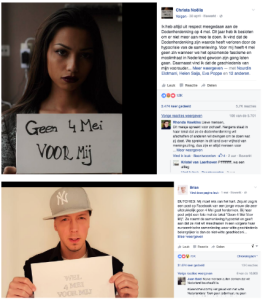
Image 2. The Facebook post of Christa Noëlla (above) and the reaction of Brian (below). Full texts of both posts are included to this analysis in Annex I.
In an interview by the Robinson Report, that was made after the post went viral, Christa Noëlla summarises her stance by stating that she does not want that history is being viewed “from one side, that history is being told as a whole. 4 May is Eurocentric, shedding light on the Holocaust, but not on colonial history. We demonstrate to the colonial propaganda of the Golden Carriage. [42] 4 May and the two minutes of silence symbolize the rise of fascism and suppression of the past.”
Christa Noëlla received an enormous amount of reactions, including many cases of hate speech (see Image 3), thereby giving reasons for the #geen4meivoormij to say that they were right in their claim that those who celebrate 4 May are insensitive towards others. Several supporters of the #wel4meivoormij campaign pointed out that having one day the remembers the victims of the Second World War, does not mean there is no space to remember other victims, and that remembering other people can be done on other days.
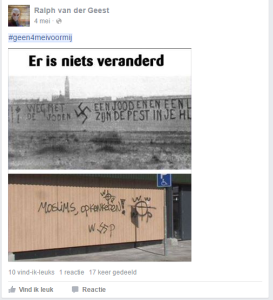
Image 3. This Facebook post “Nothing has changed”, compares discrimination of Jews in the Second World War with hate speech towards Muslims in the Netherlands. Both murals call for religious communities to go away, first the Jews (upper picture), then the Muslims (lower picture).
Other supporters of the #wel4meivoormij campaign complained about the lack of respect that the #geen4meivoormij campaign had for people that died during the Second World War and people who lost relatives in the war (see Image 4) or took a more defensive stance and accused the #geen4meivoormij campaign trying to destroy a piece of Dutch tradition (see Image 5).
-
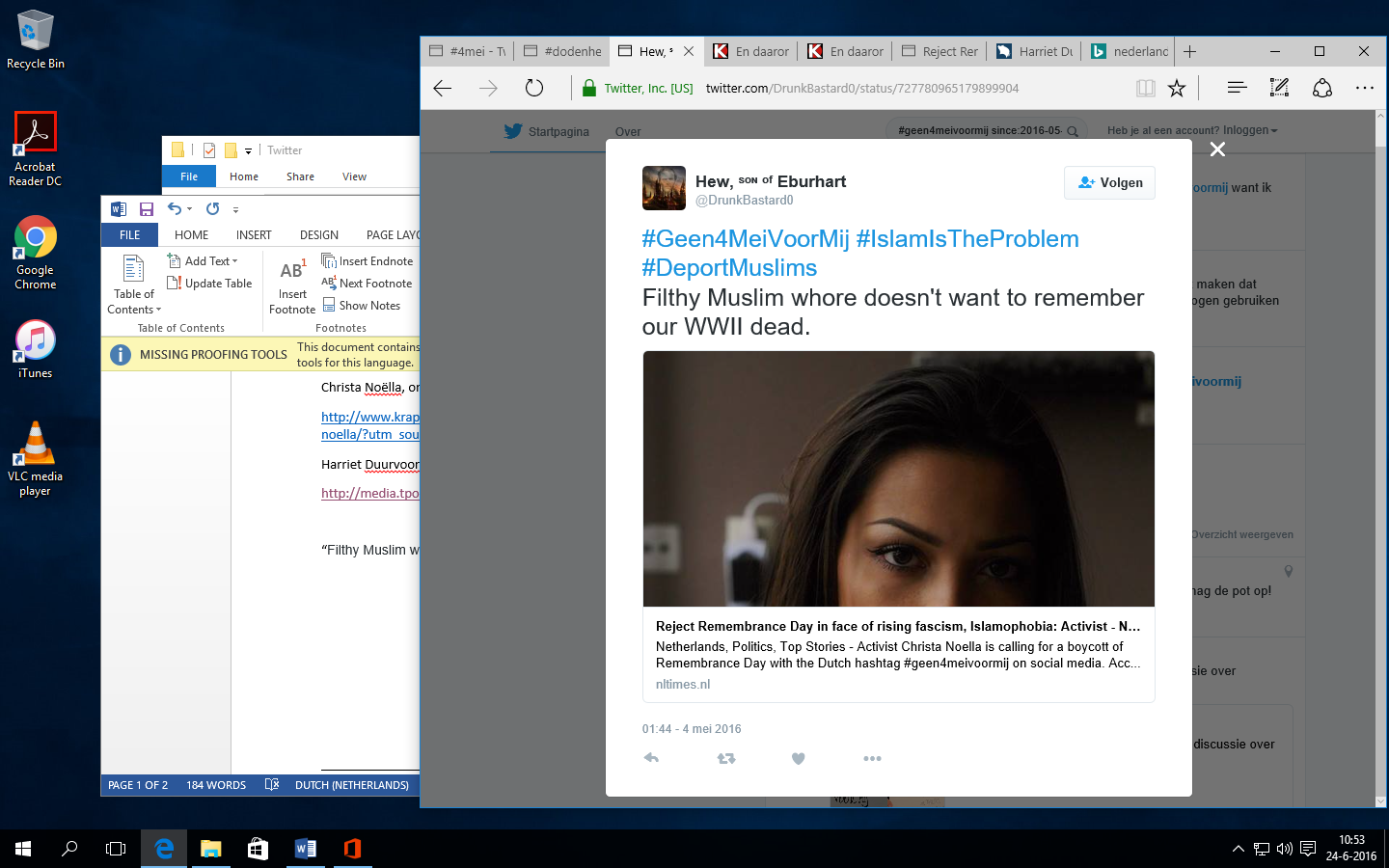
Image 4. An example of a hate speech comment directed to Christa Noëlla.
-
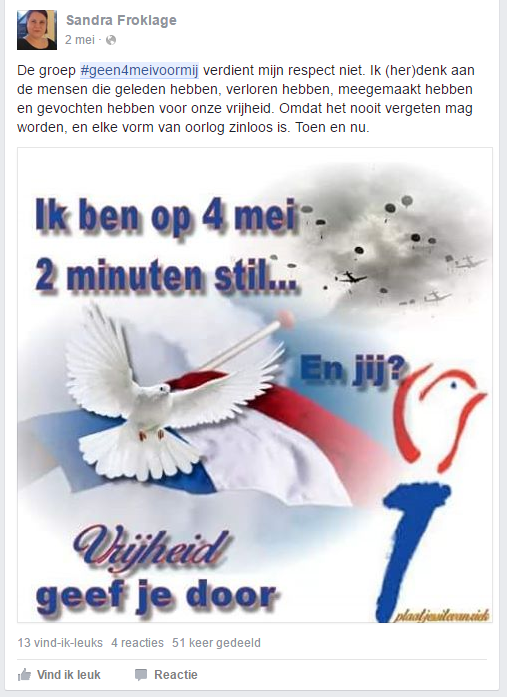
Image 5. The text reads: “The group #geen4meivoormij does not deserve my respect. I think about and remember the people that have suffered, have lost, have been through a lot and fought for our freedom. Because it can never be forgotten, and every form of war is senseless. Both then and now.” The text on the image underneath the post says “I am silent for 2 minutes on 4 May. And [what about} you? Freedom is something that you pass on.”
The president of the 4 and 5 May National Remembrance Committee, Gerdi Verbeet (who is also a politician of the Labour Party in the Netherlands, the PvdA), reacted to the debate raised by the #geen4meivoormij post by Christa Noëlla as well. Gerdi Verbeet, said that the issues that [Christa] Noëlla raised are legitimate and deserve attention, but that they should be at the centre of the 4 May celebration, arguing that 4 May is explicitly for those people who gave their lives for the freedom of the Dutch people. Instead Gerdi Verbeet emphasised the need for refugees to know what is being remembered on 4 May (See Image 6).
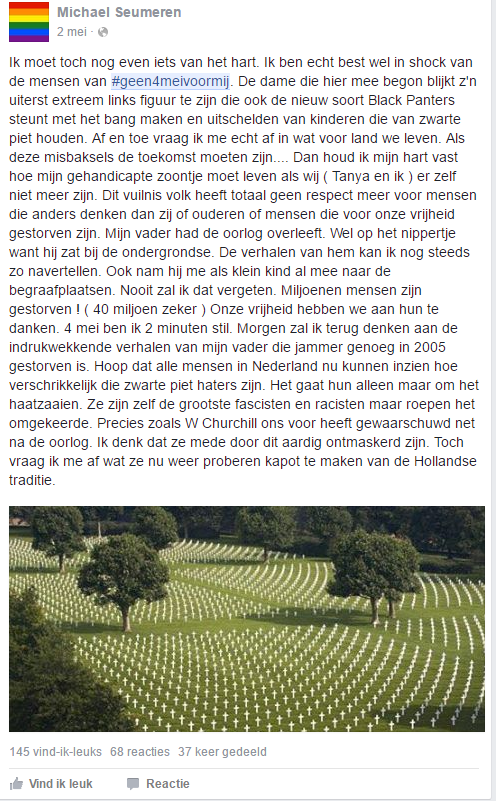
Image 6. “I have to get something of my chest. I am quite shocked by the people of #geen4meivoormij. The lady who started it, appears to be this extreme left person who wants to establish a new kind of Black Panther movement through scaring and shaming the kids who love Black Pete. Sometimes I really wonder in what kind of country we are living. If these freaks are supposed to be our future… I then fear the day my handicapped son will have to continue living when we (Tanya and myself) won’t be here anymore. This garbage people has no respect what so ever for people that think differently, nor for the older generation that had to fight for our freedom. My father has survived the war. I was close though, as he was a member of the resistance. The stories he told, I still remember vividly. He also took me to the cemeteries when I was still a kid. I will never forget those days. Millions of people died! (at least 40 million) We owe our freedom to them. On the 4th of May, I will be quiet for 2 minutes. Tomorrow I will think of the impressing stories my father, who unfortunately died in 2005, told me. I hope that all people in the Netherlands will now see how bad these Black Pete haters are. Their only goal is to spread hate. They are themselves the fascists and racists, but they claim the opposite. This is precisely what W Churchill warned us about just after the war. I think that this will help to show their true colours. But still I wonder what part of the Dutch tradition they will try to destroy next.”
Posts related to the 4 May Natioanal Remembrance Day that were not part of the #geen4meivoormij post by Christa Noëlla were mostly written to encourage others to respect the 2 minutes’ silence or explained why someone decided to be silent for 2 minutes (see for example Image 7).
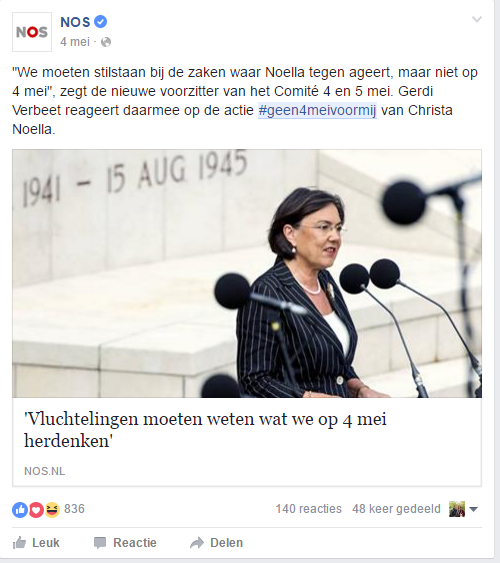
Image 7. A post by the national broadcaster summarising the reaction of Gerdi Verbeet, (president of the 4 and 5 May National Remembrance Committee) to the post by Christa Noëlla.
Most posts related to the 5 May National Remembrance Day, in contrast to the posts related to the 4 May National Remembrance Day where not about the actual meaning of the day. Frequently, the nature of the Remembrance Day was implicit when references were made to freedom and its celebration (through posting images, poems or thoughts) but these were done without historical references (See for example Image 8). More frequently, people were using social media to just share what they were doing on this particular day, such as going to one of the many festivals, concerts or just enjoying their public holiday (See for example Image 9).
-
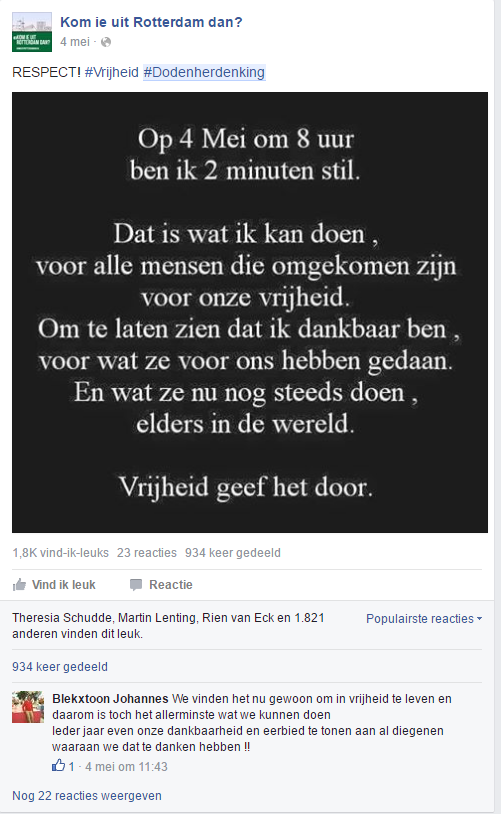
Image 8. “On 4 May, 20.00, I am quiet for two minutes. That is what I can do for all people that died for our freedom. To show that I am grateful for what they did for us. And for what they are still doing, somewhere in the world. Freedom, pass it on.”
-
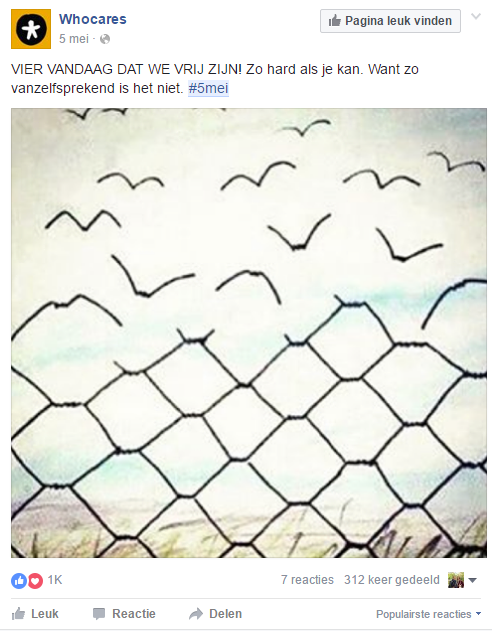
Image 9. “CELEBRATE TODAY THAT WE ARE FREE. As hard as you can. Because it is not a given thing. #5mei”
In contrast to the individuals that were posting about their feelings or activities during the day, institutes were making historical references related to the meaning of 5 May. For example, the Rijksmuseum posted a digital copy of a poster made to celebrate the liberation of the Netherlands on 5 May 1945 (See Image 10).
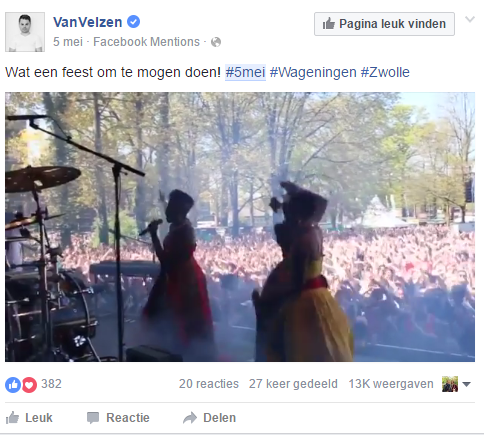
Image 10. A post from Van Velzen (a well-known singer who was also a judge on the tv-shows ‘The Voice of Holland’ and ‘the X-factor’), expressing that it is very festive (read as: an honour) to play at two of the state supported freedom festivals (commemorating the liberation of the Netherlands in 1945).
There was no large discussion or an ongoing debate on social media on the 5 May Remembrance Day, which made the posts more positive and less open to debate. There were a few exceptions, like the supporters for the right-wing Party of the Freedom (PVV) that lead to a few critical comments on their post with the national flag (see Image 11), but this was more about nationalism than about history and remembrance.
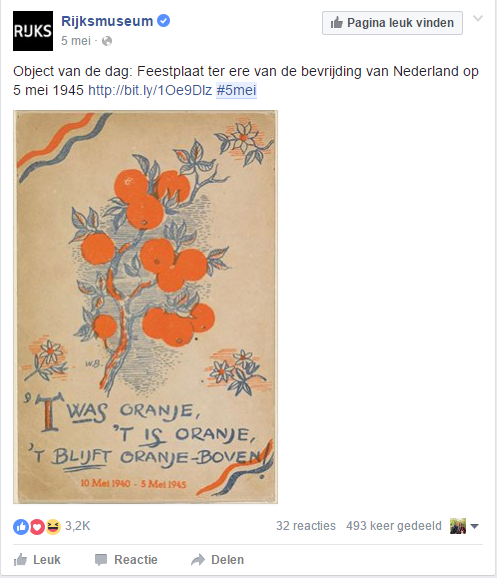
Image 11. Post by the Rijksmuseum: “Object of the day: festive in the honour of the liberation of the Netherlands on 5 May 1945”. The text on the poster reads: “It was Orange up. It stays Orange up. 10 May 1940 – 5 May 1945.” Orange refers to the name of the Royal Family of the Netherlands (the house of Orange). Up means that the banner of the house of Orange is above the tri-colour flag of the Netherlands. In order words the message of the poster is that it is good that the royal family is back (in power).
There were specifically history-related references honouring individuals who fought for the Netherlands during Second World War. Image 12, for example, is honouring a group of paratroopers that jumped into France on D-Day. It was shared 106 times and is dedicated to a group of.
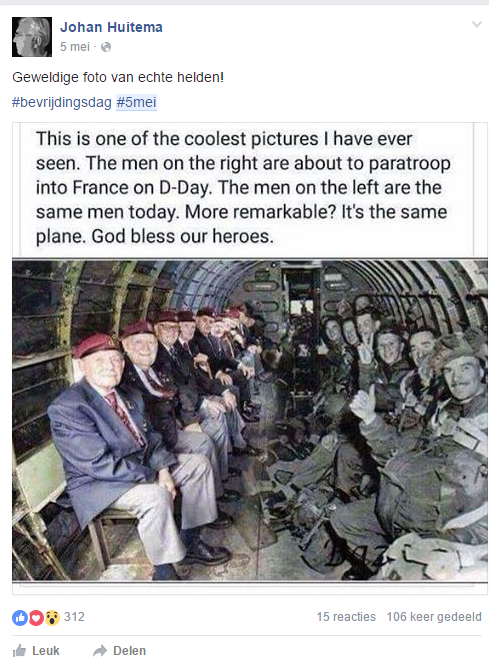
Image 12. “Amazing picture of real heroes!”
Overall, there were more posts on social media related to 4 May Remembrance Day than then 5 May Remembrance Day. This is largely due to the debate between the #geen4meivoormij and the #wel4meivoormij campaigns. Posts that were not related to this debate, the post related to 4 May were more solemn, about silence and about remembering what happened in the past, and most posts about 5 May were positive, focussed on the celebration of freedom, completely in line with the nature of both days.
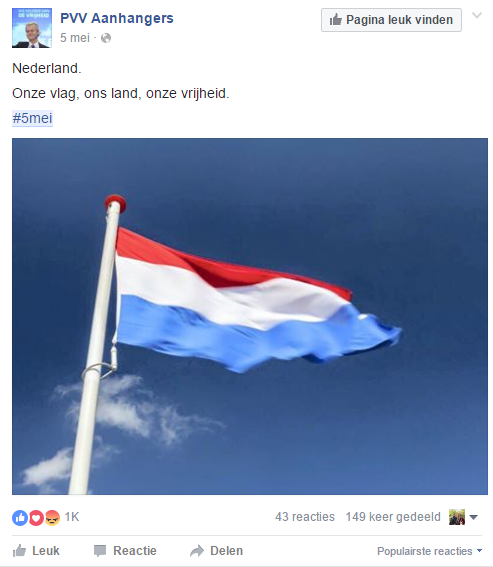
Image 13. Post by self-proclaimed PVV supporters (referring to the Party for Freedom Movement of populist politician Geert Wilders) “The Netherlands. Our flag, our country, our freedom.”
5.1.3 Remembrance days in the Netherlands on TV in 2017
On 4 May 2017, seven programs paid attention to the Remembrance Day for at least part of the program, of which four programs were broadcasted especially for the occasion of the Remembrance Day. The offer consisted of three daily talk shows, two reportages of remembrance ceremonies, and two documentaries. On commercial channels American films like The Boy in the Striped Pyjamas and Schindlers List were broadcasted, in addition to the Dutch productions of Oorlogswinter and Zwartboek. Of the seven programs described above, the best viewed program was the national remembrance ceremony, which was viewed by 2.599.000 people.[43] The most viewed TV documentary type program on the National Remembrance Day, viewed by 992.000 viewers, was ‘Oorlogsdocumentaire: Voor Joden verboden 75 jaar na de invoering van de jodenster’ broadcasted on NPO2, one of the public channels, from 21:00 – 22:00.
Almost all programs adopt an emotional approach and focus on remembrance as main theme of the program (see
Table 2). Both documentaries have an emotional approach, in which historical sources and witness accounts are used to cause an effect on the viewer’s minds. One talk show has an analytical approach, enabling multiple people explain opinions on if 4 May should solely focus on victims of war, or if for example the victims of the refugee crisis can also be commemorated.
Table 4. The history offer on TV related to 4 May Remembrance Day 2016
| Number of viewers | Name of the program | Time and Date | Channel | Type | Who accounts for the past | Approach |
| 2.599.000 | NOS Nationale Herdenking 2017 | 4 May 2017, 18:45 – 20:30 | NPO 1 | Reportage | Well-known individual(s), Voice-over/presenter, Civilians | Descriptive and emotional |
| 1.127.000 | Eenvandaag | 4 May 2017, 18:15-18:45 | NPO 1 | Talkshow | Well-known individual(s), Journalist(s), Witness(es) | Thematic |
| 1.027.000 | Dodenherdenking Waalsdorpervlakte | 4 May 2017, 19:50-20:10 | RTL 4 | Reportage | Witness(es), Voice-over/presenter | Emotional |
| 992.000 | Oorlogsdocumentaire: Voor Joden verboden 75 jaar na de invoering van de jodenster | 4 May 2017, 21:00-22:00 | NPO 2 | Documentary | Historian(s), Witness(es) | Emotional |
| 944.000 | De oorlogswinter van Roermond | 4 May 2017, 20:35-21:00 | NPO 2 | Documentary | Historian(s), Witness(es) | Emotional |
| 757.000 | Pauw | 4 May 2017, 22:45-23:45 | NPO 1 | Talkshow | Well-known individual(s), Journalist(s), Author(s) | Analytical |
| 696.000 | RTL Late Night | 4 May 2017,
22:30-23:45 |
RTL 4 | Talkshow | Well-known individual(s), Journalist(s), Witness(es) | Emotional |
On 5 May 2017, there were seven programs that were either completely or partially related to the liberation of the Netherlands. For this analysis we reviewed two concerts, one news reel, one documentary type program and three other programs. These other programs were broadcasted only on this day so were not part of a series. They were all focused on how the day is celebrated in the Netherlands. The most watched program of these was the national news broadcasted at 20.00 (viewed by 1,790,000). The most watched TV documentary type program related to the end of World War 2 was 2DOC: Het zijn maar Duitsers (They’re only Germans), broadcasted on NPO2, one of the public channels from 19:25-20:30.
Almost all programs are dedicated to how people are celebrating Liberation Day, than on the actual history. The items addressing the liberation, solely focussed on all the festivals and events that happened throughout the Netherlands. At the liberation concerts and festivals there was a small focus on how witnesses experienced the liberation, for example Radio DJ Frank van der Lende travelled to various festivals by helicopter with his grandmother, to share her liberation experiences with the audience. There was also a small controversy surrounding the Artiesten voor de Vrijheid concert. The Ambassadors of Freedom, which are chosen every year, this year consisting of popular Dutch Rap group Broederliefde, were denied their ambassadorship after a video surfaced of them chanting anti-Semitic slogans after a football match[44].
Table 5. The history offer on TV related to 5 May Remembrance Day
| Number of viewers | Name of the program | Time and Date | Channel | Type | Who accounts for the past | Approach |
| 1.790.000 | NOS Journaal | 5 May 2017, 20:00 – 20:25 | NPO 1 | News | Journalist(s), Voice-over/presenter | Thematic |
| 1.620.000 | NOS Bevrijdingsdag 2017 | 5 May 2017, 20:30 – 22:30 | NPO 1 | Concert | Mucisians | Thematic |
| 419.000 | 2DOC: Het zijn maar Duitsers | 5 May 2017, 19:25 – 20:30 | NPO 2 | Documentary | Historian(s), Witness(es) | Emotional |
| 202.000 | Klokhuis | 5 May 2017, 18:25 – 18:45 | NPO 3 | Children’s show | Historian(s), presenter | Emotional |
| 170.000 | De Tweeling | 5 May 2017,
23:00 – 1:15 |
NPO 2 | Film | Actors | Emotional |
| 192.000 | Nationale viering bevrijding 2017 | 5 May 2016, 12:00 – 13:00 | NPO 1 | Both lecture and talkshow | Journalist(s), Witness(es), Voice-over/presenter | Analytical |
| 63,000 | Artiesten voor de Vrijheid | 5 May 2017, 22:40 – 23:10 | NPO 3 | Reportage/Concert | Voice-over/presenter/ Mucisians | Thematic |
5.1.4 Remembrance days in the Netherlands on Social Media in 2017
As with the analysis on 2016, this subchapter focuses on the social media coverage of history related to the 4 and 5 May National Remembrance Days in The Netherlands in 2017. The analysis is based on all Twitter and Facebook posts using the hashtags #4mei (4May) and #dodenherdenking (Remembrance Day). These were the hashtags that were trending and related to the National Remembrance Days just before, during, and just after 4 May and 5 May in 2016.
On 4 May 2017, an initiative to expand the focus of the 4 May Remembrance Day to include the refugee crisis as well, caused a lot of commotion on social media. Initiative taker Rikko Voorberg, a Dutch theologian, proposed an alternative remembrance ceremony to commemorate all refugees that have lost their lives in the Syrian conflict or while fleeing to Europe[45]. Voorberg organised a small ceremony on Rembrandt Square, this ceremony took place at the same time as the national ceremony on Dam Square, holding a two-minute silence in honour of the victims. Around 40 people attended this ceremony.
In an open letter on Facebook Rikko Voorberg explained his action, stating that the 4 May remembrance ceremonies commemorate a “black page” in history, while the current “black page” regarding the refugee crisis is largely ignored. According to Voorberg, a parallel between the past and present should be drawn, in order to find nuance and humanity in the heated debate around the refugee crisis.
Voorbergs stance caused a lot of backlash and online hate speech, but also created an opportunity for discussion: what do we commemorate on 4 May, and why is a selection made in who we commemorate?
Both Tineke Ceelen, director of “Stichting Vluchteling” (Refugee Foundation) and Hanna Luden, director of “Centrum Informatie en Documentatie Israël” (Center for Information and Documentation Israel) argued that it is very important to commemorate the refugees who gave their life for freedom, but that 4 May is not suited for this. They pleaded that a ceremony 20 June, International Refugee Day, would be better, and keep 4 May for remembering the War. According to Luden, in order to learn from the past, we have to commemorate it. In other words, to draw lessons from the past, one has to know it.
Jewish activist and writer Robert Vuijsje wrote an essay claiming 4 May was being “de-jewished” by broadening the scope of the remembrance. By doing so, according to Vuijsje, the historical reason for the remembrance ceremony – the Holocaust – fades into the background, ignoring the importance of remembering the victims by the Jewish minority in the Netherlands. Vuijsje says in his essay: “I know there isn’t a lot of us (left), but can we [Dutch Jews] please keep the Remembrance Ceremony on 4 May?”
Another online controversy was caused when a 16-year-old Turkish boy won the yearly poetry contest, and was asked to recite his self-written poem after the two minutes’ silence during the National Remembrance Ceremony on Dam Square. A tweet about this by controversial Dutch politician and leader of the political party DENK Tunahan Kuzu, unleashed a large amount of counter tweets.
On 5 May 2017, most social media posts focused on the celebration of freedom. While some focused on the irony of celebrating freedom in a country in which freedom, in their eyes, is no more than an illusion.
An op-ed by Gerald Thus, touched upon this sentiment, though in a different way. He argues that true freedom can’t survive in a country where sexism and homophobia exist, where people are in severe debt and homeless and where refugees are being detained like criminals. According to Thus: “Freedom can only be freedom if everyone can partake in it. Freedom can only be freedom if everyone can celebrate it. Not only on 5 May, but 365 days in a year”.
Overall, posts on 4 May 2017, were a lot more related to the discussion on who Remembrance Day should focus and why. This ongoing discussion is the reason why more posts were made on 4 May. The 5 May posts were largely cynical, alluding to the question of what does freedom mean if the “free” western values, established after the Second World War are under fire in present day Europe.
5.1.5 Analysis of the Remembrance days on TV and Social Media: how does 2017 compare to 2016?
During the Remembrance Days in May it can be seen from the analysis, that the focus on TV programs and documentaries in 2016 and 2017, mainly lies on the Second World War. The commemoration of the victims of the Second World War, and other war efforts, are focused upon most, with two ceremonies that are broadcasted live – both on NPO and commercial channels. History documentaries, historic films and talk shows broadcasted during the May days are also exclusively focused on remembrance of the Second World War.
However, a shift from this focus can be seen in social media posts, where both years discussion erupted on who should be commemorated in the remembrance ceremonies and why. There is a call heard to widen the scope of remembrance. Not solely focusing on the victims of the Second World War, but also on the colonial past of the Netherlands, as seen in 2016, and the refugee crisis in 2017.
Furthermore, 5 May, seen over 2016 and 2017 on social media, has become more about the question of freedom. A shift is seen from a celebratory day, to questioning the meaning of freedom in a society increasingly threatened by terrorist attacks. What is the meaning of freedom if our western values are being threatened?
The media, including newspapers and radio programs, pick up these debates and provide background information and present different points of view. The posts on social media related to the remembrance days, include many examples of hate-speech, especially by those who feel that they are being threatened and accused. More nuanced voices can be heard as well, providing a more calm and reflective approach to an otherwise polarizing debate.
5.2 The abolition of slavery
On the first of July, the abolition of slavery in Surinam and the Antilles by the Kingdom of the Netherlands in 1863 is commemorated. The abolition of slavery consists of a ceremony at the Slavery Monument in the Oosterpark in Amsterdam, and festivals named Keti Koti (meaning “the chains are cut” in Surinamese) in different cities. Since 2016 the remembrance ceremony and the festival are held at different days (30 June for the ceremony and 1 July for the festival). As was the case with celebrating the end of WW2, it was seen fit to not have remembering and celebrating in one day. The remembrance activities are organised by the National Institute Dutch Slavery History and Heritage (NiNsee) and Foundation Amsterdam Centre.
5.2.1. The abolition of slavery on TV in 2016
For the 30 June/1 July Remembrance Days commemorating the Abolition of Slavery in Suriname and the Antilles, three programs related to this occasion were broadcasted on TV. On 30 June, the remembrance ceremony was broadcasted, and around 5 minutes of the national 30-minute news broadcast of 20.00 pm was viewed by 1.698.000 people. [46] The program that showed the remembrance ceremony was viewed by 95.000 people, and was broadcasted late in the evening. On 1 July, there was no coverage at all on the national television, including the long version of the national news broadcast. Except for the news items, there was no special TV program fully or partially related to the abolition of slavery, either on the public channels, or on the commercial channels. An overview of the complete offer of programs related to the abolition of slavery can be seen in Table below.
Table 6. The history offer on TV related to 30 June / 1 July Remembrance Day
| Number of viewers | Name of the program | Time and Date | Channel | Type | Who accounts for the past | Approach |
| 1,992,000 | NOS Journaal | 30 June 2016, 20:00-20:30 | NPO 1 | News | Voice-over/presenter | Thematic |
| 1,698,000 | NOS Journaal | 1 July 2016, 20:00 – 20:30 | NPO 1 | News | None | Thematic |
| 95,000 | NOS Herdenking Slavernijverleden | 30 Juni 2016, 23:40-00:15 | NPO 2 | News | Voice-over/presenter | Analytical |
5.2.2 The abolition of slavery on TV in 2017
On the 1 July Remembrance Day in 2017 there were three important TV programs broadcasted, shown below in Table 7[47]. All programs were broadcasted on the public broadcaster, on commercial channels, there was no mention of the remembrance of slavery. The best watched program of 1 July, witch 242.000 viewers, was “Amsterdam Sporen van Suiker” (Amsterdam Traces of Sugar). A documentary in which well-known Dutch individuals with forefathers involved in slavery go on a journey to uncover their roots. The documentary has an emotional approach.
Two programs showed the Remembrance ceremony, one live – on NPO 1 – watched by 182.000 people. The other program was a summary of the ceremony, substituted with items on the Dutch history of slavery. This program was broadcasted on NPO 2, and viewed by 110.000 people.
Table 7. The history offer on TV related to 1 July 2017 Remembrance Day
| Number of viewers | Name of the program | Time and Date | Channel | Type | Who accounts for the past | Approach |
| 242.000 | Amsterdam Sporen van Suiker | 1 July 2017, 20:20-21:20 | NPO 2 | Documentary | Historian(s), Witness(es) | Emotional |
| 182.000 | NOS Herdenking Slavernijverleden | 1 July 2017, 13:00-14:20 | NPO 1 | Reportage | Well-known individual(s), Voice-over/presenter, Civilians | Descriptive/emotional |
| 110.000 | NOS Herdenking Slavernijverleden | 1 July 2017, 19:30-20:20 | NPO 2 | News | Voice-over/presenter, Well-known individual(s) | Descriptive/emotional |
5.2.3 The abolition of slavery on Social Media in 2017
To perform this part of the analysis, all usage of the hashtag Keti Koti (#KetiKoti) in the days surrounding 1 July 2017, was researched. It includes posts from twitter and Facebook.
On social media it can be seen that a discussion is started surrounding the memory of slavery. Most users emphasize that there is still not enough done in the Netherlands to acknowledge and remember this part of history[48]. The Dutch history education in secondary schools is challenged, stating that slavery is often skipped, or barely touched upon[49].
Many question why Keti Koti isn’t remembered in the same way as 4 May, and why so little attention is paid to it[50]. Some people even pose the question if it can be compared to the holocaust, as slavery caused many dead related to ethnicity.
In the case of Keti Koti remembrance of slavery, especially on social media, it goes hand in hand with blatant racism. From people wondering why white slaves aren’t commemorated, to remarks accusing people to use their dark skin-color to cause a division in Dutch society by remembering slavery. Profanities were used, as well as numerous remarks telling people to go back to Africa[51].
5.2.4 Analysis of the abolition of slavery on TV and Social Media: how does 2017 compare to 2016?
From the analysis it becomes clear that the TV programs concerning the celebration of Keti Koti have shifted from 2016 to 2017. In 2017 the 1 July ceremony of the Abolition of Slavery is broadcasted live, with an in-depth program dedicated to it later on the evening, followed by a documentary. Tones have also shifted. Where the main approach in 2016 was mainly analytical and descriptive, 2017 saw a more emotional approach to programme making.
The amount of viewers also increased in 2017, mostly due to the fact that the viewing times changed from midnight in 2016, to prime-time in 2017.
5.3 Europe Day
Europe day is celebrated annually in EU member states since 1985 on 9 May. On this day it is commemorated that on this date in 1950, French minister Robert Schuman made a proposal to make the European Coal and Steel Community a joint organisation under French and West-German supervision, thus taking the first steps toward the European Union as it is known today.
5.3.1 Europe Day on TV in 2016
On 9 May there was no attention paid to the commemoration of Europe Day. It was not mentioned in the news broadcast of the National Broadcasting Foundation, and there were no special programs broadcasted dedicated to Europe Day. There was however brief attention in the news broadcast for the celebration in Russia on the 9th of May on which they celebrate the victory of the Soviet Union over Nazi-Germany in 1945. And in terms of mentions of the European Union, it was stated that professor in Turkish languages and cultures, Erik-Jan Zürcher, is returning a price he won in 2005. He felt that Turkey is becoming a dictatorial state and that the Turkish people are becoming more and more separate from the European Union.
5.3.2 Europe Day on Social Media in 2016
Due to the limited attention Europe Day received in the media, there are no noteworthy social media posts on this day. There were no tweets using the hashtag #Europadag2016, no Instagram posts and on Facebook the only posts regarding Europe Day were shared agenda’s on what people could do, related to the European Union, on 9 May.
5.3.3 Europe Day on TV in 2017
On 9 May 2017, there was again no special interest in Europe Day on Dutch television. It was not mentioned in the news broadcast of the National Broadcasting Foundation, and there were no dedicated programs broadcasted. The only program related to Europe on Dutch television, was the Eurovision Song Contest, in which Europe Day was also not mentioned.
5.3.4 Europe Day on Social Media in 2017
Again, due to the limited attention Europe Day received on Dutch national television, the analysis on social media posts concerning Europe Day in 2017, will be short. The hashtag #Europadag2017 was used only used once on twitter, and only one post concerning Europe Day appeared on Facebook. The Facebook post is most noteworthy, explaining in a nuanced voice how, according to the writer, the EU has changed, and what changes need to be made in order to restore the core values of the EU.
[one_half]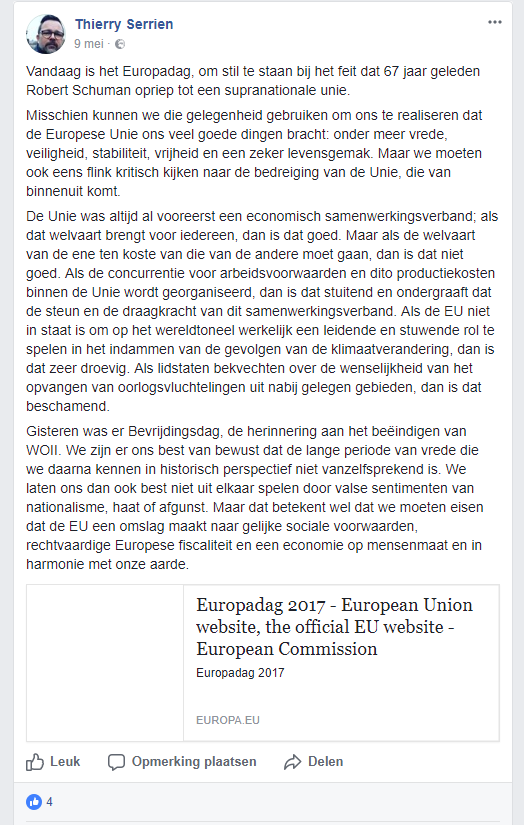
Today it is Europe Day, to commemorate the fact that 67 years ago, Robert Schuman called for a supranational union.
Perhaps we can use this occasion to realise that the European Union has brought us so many good things: among other things peace, safety, stability, freedom and a certain ease in life. But we also have to look critically at the threat of the Union that comes from within.
The Union was first and foremost an economic cooperation; if that brings prosperity to everyone, then that is good. But if this prosperity comes at the cost of another, then that isn’t good. When competition for working conditions and production costs are organized within the Union that is astounding, and undermines the support and capacity of this cooperation. If the EU isn’t capable to take a leading and driving force in the world when it comes to lower the risks of climate change that is very sad. When member states are arguing over taking in refugees from neighbouring areas that is shameful.
Yesterday it was Liberation Day, the memory of the end of WWII. We are quite aware that this long period of peace that we know after that does not come naturally in a historical perspective. We will then not be played out against each other by false sentiments of nationalism, hate or jealousy. But that does mean that we have to demand the EU makes a turn toward equal social conditions, a justified European fiscal system, and an economy made for people in harmony with our earth.
[/one_half_last]
Celebrate #EuropeDay and the peace and solidarity it has brought Europe. Watch how it all began!
For over 60 years! #peace #Europeday2017
5.3.5 Analysis of Europe Day on TV and Social Media: how does 2017 compare to 2016?
To conclude this part, Europe Day received little attention, compared to other Remembrance days. In both years it is not mentioned in news broadcasts, and barely mentioned online. Reflection is limited to a single post on Facebook, not causing an extensive online discussion on what, how, who and why we remember as seen with the other Remembrance Days.
6. Conclusion
The history offer on TV in the Netherlands mainly looks at history through a national lens. The history offer mostly consist of national productions co-financed with public money in the form of history documentaries. The most watched programmes are part of a series giving an overview of national history in a particular period. This includes parts of history that are seen in a positive light (such as the Golden Age), but also parts of history which are seen in a negative light (including Slavery and the Colonial past). Movies on history produced in the Netherlands, are mostly produced commercially. These commercial movies focus on national heroes, like Michiel de Ruyter and Kenau, or on the Second World War, like Zwartboek.
Of all three Remembrance Days covered in this analysis, the Remembrance Day that is commemorating the Dutch victims of wars since the Second World War, on 4 and 5 May, receives most coverage on TV. In both years analysed, these ceremonies received most attention, and had most viewers.
Whereas the broadcast of the Remembrance Ceremony of 4 May – 2016 and 2017 – was watched by over two million viewers, the Remembrance Ceremony of 30 June and 1 July, was watched by under 200.000. The difference in time of the broadcast – the 30 June 2016 ceremony was broadcasted at 23:40 – 00:15, and the 1 July 2017 ceremony at 13:00 – 14:20 – is likely to be part of the explanation why less viewers watched this ceremony compared to the ceremony on 4 May, which is broadcasted at 20:00.
Europe Day received virtually no attention both years, with no mentions on TV, and subsequently no social media coverage.
On social media, it can also be seen from the analysis that 4 May receives most attention. Both years discussions erupted on who to commemorate and why. From these discussions, it becomes clear that remembrance in the Netherlands is still a very sensitive subject.
Several debates related to history in the Netherlands are related to the colonial past. Examples are the debate triggered by the #Geen4meivoormij post by Christa Noëlla, the debate about the use of the Golden Carriage by the King and Queen during prinsjesdag, the protest related to the release of the Michiel de Ruyter movie, the ongoing debate about the Black Pete, and the celebration of the VOC mentality by then Prime Minister Jan Peter Balkenende.
Another debate is also visible: until what extent can historic remembrance be applied to current events? Rikko Vervoorts attempt to expand the scope of Remembrance to the refugee crisis was met with a lot of online resistance.
Both years it becomes visible that the lack of filtered messages on social media, can contribute to an enormous amount of hate, but that it can also create a more nuanced and valuable discussion.
Annex 1. Full texts of the #geen4meivoormij and #wel4meivoormij posts
Post by Christa Noëlla
“I always participated out of respect in the 4 May Remembrance Ceremony commemorating the dead. This year I decided not to participate [in this ceremony] any more. I belief that the 4 May Remembrance Ceremony has lost its value because of the hypocrisy of the [Dutch] society. For me, 4 May, has no purpose when we allow the rise of fascism and hatred of Muslims to happen. In addition, I believe that the history of my ancestors, should also be remembered. I don’t want to join in a Euro-centric approach to history, where the history of white people is more important than the history of non-white people, which is a history in which the Netherlands had a very important role. I cannot remember the victims of fascism with a straight face, when we allow Nazi’s to march in Dutch cities every month, under the banner of freedom of speech. How can we agree amongst ourselves that this terrible past is never allowed to happen, when in the meantime we are bombing Syria? I don’t join the 4 May Remembrance Ceremony. I think it is a much more beautiful sign if we provide a better future for the young generation, by fighting fascism in the present and by decolonization. Especially because we should learn from the past and not forget. #geen4meivoormij”[52]
Post by Brian
DUTCHIES: I have to get something of my chest. Just now I saw a post on Facebook by a young woman who very explicitly is not going to commemorate 4 May. Alongside her post shines a picture with the text “No 4 May for me”. She calls the society hypocritical and says she does not want to participate in what she calls a Euro-centric society where white history is more important than not-white history. As a child, I always used to be the one laying the wreath during the annual national 4 May Remembrance Ceremony. I witnessed how elderly people were crying of sadness, how public speakers where stuttering because of emotions, and how children were hugging each other when they realised that something terrible as this [World War 2 and the Holocaust] had really happened in our country. Those people who lived through the war were left with terrible inner wounds, and I may be bitter, but I find the Facebookpost of this young lady lacking so much respect, that I am disgusted by it. Why would you not honour an important Remembrance Day, solely to make a point about something totally different? And, more importantly, why would you associate yourself with such a statement, when you know it is lacking respect towards the victims, the descendants and Dutch history in general? The way in which she makes her point is unique, but she lacks respect for the dead of the war from the past, and has no respect for the young people who were mown down at the beaches of Normandy in order to liberate us [in the Netherlands]. And all of this, whilst it would be possible for her to make a point without involving the 4 May Remembrance Day. For the moment, enough about this young lady, I will come back to her later.
The original meaning of the 4 May Remembrance Day was only to commemorate the Dutch victims from the Second World War. Since 1961 a broader definition of the Remembrance Day is officially used to remember ALL victims and people who died since the outbreak of the Second World War, therefore also including people from different races and nationalities. The official statement about the 4 May Remembrance Days is as follows: “During the National Remembrance Ceremony we commemorate everyone – civilians and military – who died or were killed in the Kingdom of the Netherlands or anywhere in the world during war and peace missions since the outbreak of the Second World War”.
Therefore, the Netherlands is not self-centred at all, but rather emphatic in the way the 4 May Remembrance Day is held. It even remembers people who died during peace missions, such as Lebanon, Bosnia [-Herzegovina] or Afghanistan. Does Turkey remember all the dead from Afghanistan? Does Morocco, remember the dead from Syria? Does Surinam remember all the dead from Bosnia or Kosovo?
One day later, on 5 May, the liberation [of the Netherlands] from the German occupiers is celebrated. A day where in 1945 million people were liberated from repression, hunger and torture. On 15 August, the Indian [Indonesian] community in the Netherlands is celebrating Independence Day because of the Japanese surrender in the Dutch-Indies in 1945. Also, on these days the Netherlands is not self-centred.
Let me return to the young lady from the Facebook post. She says that she is not able to commemorate the victims of Fascism with a straight face when we allow Nazi’s to march in Dutch cities every month, under the banner of freedom of speech. She writes: “How can we agree amongst ourselves that this terrible past is never allowed to happen, when in the meantime we are bombing Syria?”
We? WE?!
In the meantime, young lady, WE are providing shelter in our tiny country at the moment to more than 42.000 refugees, of which well over 43% comes from Syria, and others from Iraq, Afghanistan and Eritrea. This number has increased almost five-fold compared to 2014. In the meantime, young lady, I am part of the society that you are all treating the same, whilst you imply that you are against generalisations and discrimination. In the meantime, young lady, I am part of the group of homosexuals that are in THIRTEEN countries in the Middle East alone, will be punished when they express their feelings. In Iran, Saudi-Arabia and Yemen homosexuals getting the death penalty is in the order of the day, and also on Gaza and Turkish-Cyprus being homosexual is a criminal offense. In the meantime, young lady, my driving instructor is Surinam, my [music] band member is Belgian, one of my music crew is Jewish and my best female friend is a Muslim. In the meantime, young lady, I am together with million other people in the Netherlands, both autochthone and allochthone, doing my very best to make a beautiful future inside our country. That is also “US”… Your intentions are probably good, and your attempt noble, but if you don’t treat others with respect, don’t expect to be respected in return. On 4 May I will take part in the Remembrance Ceremony, just because I have respect for the other, regardless of their sexual orientation, colour or race. #WEL4MEIVOORMIJ”.[53]
Annex 2. Full text of Rikko Voorbergs Facebook post about 4 May 2017
Open letter[54]: Why we wanted to commemorate in freedom and why we are not going to do that.
“During the National Memorial Day we commemorate the Dutch victims of the Second World War and wars that followed afterwards”, it says on the website of The National Committee of the 4th and 5th May. And so we reflect/dwell upon the black page and the victims of the previous generation. To ensure the message stays alive, a link with the past is always sought after –and rightly so. During speeches on the “Dam” fightable lines, such as “that we should never forget”, “this never again” and “pas freedom on” echo.
But what message do we want to keep alive? To whom do we pass freedom on if we gather with all liberated people? If you talk about victims of war violence, images of death bodies on sea, gas attacks and ‘’slaughterhouse of Assad’’, lifeless body of Aylan Kurdi on the beach of Bodrum, the murders of Sjiites, Yezidi and Arab Christians will unfortunately loom.
The Refugee crisis is the black page of today. We would like to realise how poignant it is that people die because we made that freedom so unreachable.
We don’t want to suppress the Second World War, let alone hijack. But we do want to connect the refugees that died to the responsibility of commemorating that the Second World War has given us.
Where we wanted to give our feelings of responsibility, love and respect a place in society, we hit a nerve. Many citizens but also interest organisations have indicated us, that not everyone can be commemorated. And on the 4th of May there is only room for the victims of the Second World War.
Because angry words slowly passed on to angry deeds we have decided, with pain in our hearts, to change our initiative. We will gather with all involved to follow the ceremony and to reflect on what the previous couple of days for God’s sakes has happened.
We hope we have planted a few seeds to have more connection on National memorials in the furture.
We call upon everyone’s responsibility that commemorating victims of the Second World War brings us: ‘’So that we will not forget, never again, pass on the freedom!’’
Rikko Voorberg
Matthijs Jaspers
Katinka Simonse
Note:
[1] NPO is an acronym of Nederlandse Publieke Omroep, which translates to National Public Broadcaster. This broadcaster receives funding from the Dutch Government.
[2] RTL is part of the RT Group, a commercial company that owns radio and TV channels in many European countries, with Bertelsmann currently as its main owner. RTL Netherlands is the result of several mergers, including merger with Vereniging Veronica.
[3] There used to be a fee to cover the cost of producing programs for public channels paid by every household with a TV, but a law adopted in 1999 changed this into a system where the costs for production and broadcasting are paid by general tax money. The text of the law can be found here https://www.eerstekamer.nl/behandeling/19991228/publicatie_wet_4 (Accessed 30 December 2016).
[4] Internet Movie Database, Andere Tijden TV Series, http://www.imdb.com/title/tt1475261/ (Accessed 27 December 2016).
[5] Internet Movie Database, De Gouden Eeuw TV Series, http://www.imdb.com/title/tt2955322/ (Accessed 27 December 2016). The episodes of ‘De Gouden Eeuw’ are available at http://www.npo.nl/de-gouden-eeuw/POMS_S_VPRO_113119 (Accessed 27 December 2016).
[6] Internet Movie Database, De IJzeren Eeuw TV Series, http://www.imdb.com/title/tt4574744/ (Accessed 27 December 2016). The Iron Century refers to process of industrialisation that happened in the 19th Century. The episodes of ‘De IJzeren Eeuw’ are available at http://www.npo.nl/de-ijzeren-eeuw/VPWON_1262790 (Accessed 27 December 2016).
[7] The episodes of ‘De Slavernij’ available at http://www.npo.nl/de-slavernij/POMS_S_NTR_125089 (Accessed 27 December 2016).
[8] The official webpage of the series about liberation “Na de bevrijding” http://www.nadebevrijding.nl/ (Accessed 27 December 2016). The episodes of ‘Na de bevrijding’ are available at http://www.npo.nl/na-de-bevrijding/POMS_S_NTR_465238 (Accessed 27 December 2016).
[9] Internet Movie Database, Het Koninkrijk TV Series, http://www.imdb.com/title/tt4224124/ (Accessed 27 December 2016). The episodes of ‘Het Koninkrijk’ are available at http://www.npo.nl/nos-het-koninkrijk/POMS_S_NOS_508604 (Accessed 27 December 2016).
[10] The episodes of ‘Drie Vorstinnen’ are available at http://www.npo.nl/drie-vorstinnen-van-oranje/POW_03204578 (Accessed 27 December 2016).
[11] The episodes of ‘Drie Koningen’ are available at http://www.npo.nl/drie-koningen-van-oranje/POMS_S_MAX_425272 (Accessed 27 December 2016).
[12] Internet Movie Database, Goede Hoop TV Series, http://www.imdb.com/title/tt6710142/?ref_=nv_sr_1 (Accessed 25 September 2017). The episodes of ‘Goede Hoop’ are available at https://www.npo.nl/goede-hoop/VPWON_1259462 (Accessed 25 September 2017).
[13] Internet Movie Database, In Europa TV Series, http://www.imdb.com/title/tt1190697/ (Accessed 27 December 2016).
[14] Internet Movie Database, Black Book, http://www.imdb.com/title/tt0389557/ (Accessed 27 December 2016).
[15] J.C.H. Blom, ‘Gezien: Zwartboek’, https://www.historischnieuwsblad.nl/nl/artikel/6859/gezien-zwartboek.html.
[16] Internet Movie Database, Michiel de Ruyter, http://www.imdb.com/title/tt2544766/ (Accessed 27 December 2016).
[17] See http://www.historien.nl/michiel-de-ruyter-en-de-slavenhandel/ (Accessed 30 December 2016)
[18] The remark about the VOC mentality refers to a statement by then Prime Minister Jan Peter Balkenende in 2006, who said that the Netherlands needed a VOC mentality. The VOC is the acronym of the Dutch East Indian Company. Balkenende was widely criticised for this remark because the Dutch East Indian Company was largely responsible for Colonialism and slavery.
[19] Internet Movie Database, Kenau, http://www.imdb.com/title/tt2512170/ (Accessed 27 December 2016).
[20] Internet Movie Database, Nova Zembla, http://www.imdb.com/title/tt1911607/ (Accessed 27 December 2016).
[21] For comparison: The total population of the Netherlands is approximately 17 million people. Central Bureau of Statistics, https://www.cbs.nl/nl-nl/visualisaties/bevolkingsteller (Accessed 30 December 2016).
[22] Internet Movie Database, The Young Victoria, http://www.imdb.com/title/tt0962736/ (Accessed 30 December 2016).
[23] The descriptions of the different approaches are as follows: Analytical: the person who accounts for the past makes use of different perspectives, tries to emphasize more sides, describes confrontation between forces, situations, characters exhibiting similarities and differences. Emotional: the person who accounts for the past makes use of documents/stories aimed at creating an effect on spectators’ minds, especially as regards to stressing situations. Thematic (descriptive): all aspects of the program relate to the same subject, without the aim of reaching a particular effect at the audience.
[24] More information on Stichting Kijkonderzoek: https://www.kijkonderzoek.nl/about-sko (Accessed 24 June 2016).
[25] Source: Stichting Kijkonderzoek.
[26] News article published on the website of the community of Amsterdam, https://www.amsterdam.nl/stadsarchief/nieuws/verborgen-verleden/ (Accessed 24 June 2016).
[27] Article with an interview with the presenter: https://www.televizier.nl/categorie/overig-tv-nieuws/presenter-hans-goedkoop-over-de-gouden-eeuw‑‑.11822.lynkx (Accessed 24 June 2016).
[28] Ibid.
[29] Before 1961 the commemoration was limited to the Dutch victims of the Second World War only.
[30] http://www.4en5mei.nl/over-het-comite?gclid=CjwKEAjwtLO7BRDax4-I4_6G71USJAA6FjN1y9ttieCp7Acl3SL90H04xCuYaNWXLo2AP3Zgy3Xe-xoC3XTw_wcB (Accessed 24 June 2016).
[31] Source: Stichting Kijkonderzoek.
[32] The descriptions of the different approaches are as follows: Analytical: the person who accounts for the past makes use of different perspectives, tries to emphasize more sides, describes confrontation between forces, situations, characters exhibiting similarities and differences. Emotional: the person who accounts for the past makes use of documents/stories aimed at creating an effect on spectators’ minds, especially as regards to stressing situations. Thematic (descriptive): all aspects of the program relate to the same subject, without the aim of reaching a particular effect at the audience.
[33] Amsterdam had weer even zijn ‘hongerbrug’, NOS, http://nos.nl/artikel/2103237-amsterdam-had-weer-even-zijn-hongerbrug.html (Accessed on 31 December 2016.
[34] The descriptions of the different approaches are as follows: Analytical: the person who accounts for the past makes use of different perspectives, tries to emphasize more sides, describes confrontation between forces, situations, characters exhibiting similarities and differences. Emotional: the person who accounts for the past makes use of documents/stories aimed at creating an effect on spectators’ minds, especially as regards to stressing situations. Thematic (descriptive): all aspects of the program relate to the same subject, without the aim of reaching a particular effect at the audience.
[35] The background to the 4 May and 5 May National Remembrance Days can be found in the previous section.
[36] De Volkskrant 2 May 2016, http://www.volkskrant.nl/media/jonge-activisten-boycotten-4-mei-om-hypocrisie~a4293453/ (Accessed 24 June 2016).
[37] https://www.nrc.nl/nieuws/2016/05/03/die-stille-twee-minuten-symboliseren-het-hedendaagse-fascisme-a1403437 (Accessed 27 December 2016).
[38] Among others: http://www.nltimes.nl/2016/05/03/reject-remembrance-day-face-rising-fascism-islamophobia-activist/ (NL Times), http://www.metronieuws.nl/nieuws/binnenland/2016/05/ophef-vanwege-hashtag-geen4meivoormij (Metronieuws), http://www.nrc.nl/nieuws/2016/05/03/die-stille-twee-minuten-symboliseren-het-hedendaagse-fascisme (NRC), and http://nos.nl/artikel/2103030-vluchtelingen-moeten-weten-wat-we-op-4-mei-herdenken.html (NOS) (All accessed 24 June 2016).
[39] http://forum.fok.nl/topic/2299612 (Accessed 27 December 2016).
[40] The Post Online NL, http://media.tpo.nl/2016/05/02/harriet-duurvoort-zegt-neen-geen4meivoormij/ (Accessed 27 June 2016).
[41] The debate on Black Peter has been ongoing in the Netherlands for decades, but has been fierce in recent years, following a statement by the United Nations’ Working Group of Experts on People of African Descent, on the conclusion of its official visit to the Kingdom of the Netherlands, 26 June-4 July 2014 (http://www.ohchr.org/en/NewsEvents/Pages/DisplayNews.aspx?NewsID=14840&LangID=E, Accessed 27 December 2016) concluding that the figure of Black Pete is racist. Black Pete is part of the Saint Nicolas traditional celebration, in which children get presents, celebrated by most people in The Netherlands. The issue is that Black Pete traditionally is black-faced, and has other features (such as red lips, golden earrings, clothing and afro hair) that part of the negro stereotype, seen as offensive in most countries, that he used to be a scary figure and now is a silly figure. Critics point out the similarities between Black Pete and these negative stereotypes, the fact that some young children associate Black Pete with black people, and past of the Netherlands in terms of colonies and slavery. Most defenders of the tradition point out that their intensions are not racists and see the critics as a threat to the national heritage and identity. The debate has led to changes over the last few years, but the changes are too fast and too significant for some, and too slow and too insignificant for others.
[42] The golden carriage refers to another controversy about history in the Netherlands. The golden carriage plays a central role during the annual Prinsjesdag ceremony when the King and Queen travel in the carriage as part of a parade from the royal palace in The Hague to the Ridderzaal (next to the parliament) where the King gives his state of the union address. The golden carriage is controversial because of an image on the side portraying enslaved people who are black in an uncritical manner. Critics say that it is inappropriate for an object which such an image to play such a central role during a national ceremony, especially given the colonial past of the Netherlands, and would like to see the golden carriage not being used, or to be put in a museum. Supports of the golden carriage, either say that slavery and the colonial past are part of the history of the Netherlands and that the past should not be white-washed, or say that people should not be so sensitive and that traditions should be respected.
[43] Source: Stichting Kijkonderzoek.
[44] NRC: https://www.nrc.nl/nieuws/2017/03/09/broederliefde-toch-geen-ambassadeur-van-de-vrijheid-a1549472 (Accessed 28-09-2017)
[45] Full transcript of Voorberg’s letter can be found in Annex 2.
[46] Source: Stichting Kijkonderzoek.
[47] Source: Stichting Kijkonderzoek.
[48] NRC: https://www.volkskrant.nl/opinie/harriet-duurvoort-schande-dat-uitgerekend-nederland-geen-slavernijmuseum-heeft~a4504622/?hash=f4afaae8ba7b6144c66912cf3e397eb7843896b2 (Accessed 28-09-2017)
[49] De Volkskrant: https://www.volkskrant.nl/opinie/commentaar-slavernijverleden-verdient-aandacht-maar-nationale-feestdag-is-niet-de-manier~a4504115/ (Accessed 28-09-2017)
[50] Trouw: https://www.trouw.nl/samenleving/-waarom-herdenken-weinigen-de-slavernij-~a824fb8a/ (Accessed 28-09-2017)
[51] Joop: https://joop.vara.nl/nieuws/racisten-gaan-los-op-livefeed-slavernijherdenking-nos (Accessed 28-09-2017)
[52] Original Text (in Dutch): “Ik heb altijd uit respect meegedaan aan de Dodenherdenking op 4 mei. Dit jaar heb ik besloten om er niet meer aan mee te doen. Ik vind dat de Dodenherdenking zijn waarde heeft verloren door de hypocrisie van de samenleving. Voor mij heeft 4 mei geen zin wanneer we het opkomende fascisme en moslimhaat in Nederland gewoon zijn gang laten gaan. Daarnaast vind ik dat de geschiedenis van mijn voorouders ook herdacht moet worden. Ik wil niet meedraaien in een eurocentrische samenleving waar witte geschiedenis belangrijker is dan de niet-witte geschiedenis, waar Nederland een zeer belangrijke rol in heeft gespeeld. Ik kan niet met een stalen gezicht de slachtoffers van fascisme herdenken wanneer wij elke maand nazi’s laten rond marcheren in de Nederlandse steden onder het mom van vrijheid van meningsuiting. Hoe kunnen wij het ermee eens zijn dat dit vreselijke verleden nooit meer mag gebeuren terwijl wij ondertussen bommen op Syrië gooien? Ik doe niet meer mee aan Dodenherdenking. Ik denk dat het een veel mooier signaal is als wij een betere toekomst kunnen achterlaten voor de jongere generatie door het hedendaags fascisme te bestrijden en door te dekoloniseren. Juist omdat wij moeten leren van het verleden en niet moeten vergeten,”.
[53] Translated from: “DUTCHIES: Mij moet iets van het hart. Zojuist zag ik een post op Facebook van een jonge vrouw die zeer uitdrukkelijk geen 4 Mei gaat herdenken. Bij haar post prijkt een foto met de tekst “Geen 4 Mei Voor Mij”. Ze noemt de samenleving hypocriet en geeft aan dat ze niet wil meedraaien in een volgens haar eurocentrische samenleving waar witte geschiedenis belangrijker is dan de niet-witte geschiedenis. Als kind was ik steevast een kranslegger tijdens de jaarlijkse nationale Dodenherdenking. Ik heb daarbij bejaarden zien huilen van verdriet, publieke sprekers horen stotteren van emotie en kinderen zien knuffelen nadat bij hun het besef was binnengedrongen dat zoiets vreselijks dan toch echt gebeurd was in ons land. Zij die de oorlog hebben meegemaakt hebben hieraan vreselijke innerlijke wonden overgehouden en misschien ben ik bitter maar de Facebookpost van deze jongedame vind ik dermate respectloos dat ik er van moet walgen. Waarom zou je een belangrijke herdenkingsdag niet eren enkel en alleen om een statement te maken over heel iets anders? En nog belangrijker, waarom zou je zo’n dag met je statement associëren als je weet dat dit heel respectloos is naar slachtoffers, nabestaanden en de Nederlandse geschiedenis in zijn algemeenheid? Uniek dat ze zo haar punt maakt, maar dan heeft ze totaal geen respect voor de oorlogsdoden uit het verleden en geen respect voor de jonge mannen die op de stranden van Normandië zijn neergemaaid om ons te bevrijden. En dat terwijl ze ook haar punt had kunnen maken zonder daarbij Dodenherdenking te betrekken. Voor nu even genoeg over deze dame. Daar kom ik zo op terug.
De oorspronkelijke opzet van Dodenherdenking ging uitsluitend om de Nederlandse slachtoffers in de Tweede Wereldoorlog. Sinds 1961 wordt officieel een ruimere definitie van Dodenherdenking gehanteerd die ALLE oorlogsslachtoffers of omgekomenen sinds het uitbreken van de Tweede Wereldoorlog omvat, dus óók mensen van andere rassen en nationaliteiten. Het officiële gedenkschrift voor Dodenherdenking op 4 mei luidt:
“Tijdens de Nationale Herdenking herdenken wij allen – burgers en militairen – die in het Koninkrijk der Nederlanden of waar ook ter wereld zijn omgekomen of vermoord sinds het uitbreken van de Tweede Wereldoorlog, in oorlogssituaties en bij vredesoperaties.”
Nederland toont zich dus totaal niet eenkennig maar juist eerder begripvol bij de invulling van Dodenherdenking en herdenkt zelfs mensen die zijn omgekomen bij vredesoperaties zoals in Libanon, Bosnië of Afghanistan. In Turkije, herdenken ze daar alle doden van Afghanistan? In Marokko, herdenken ze daar alle doden van Syrië? In Suriname, herdenken ze daar alle doden van Bosnië / Kosovo?
Een dag later, op 5 mei, wordt de bevrijding van de Duitse bezetting gevierd. Een dag waarop in 1945 miljoenen mensen werden bevrijd van onderdrukking, honger en marteling. Op 15 augustus viert de Indische gemeenschap binnen Nederland Bevrijdingsdag vanwege de Japanse capitulatie in Nederlands-Indië in 1945. Ook op deze dag(en) toont Nederland zich dus niet eenkennig.
Terug naar de jongedame van de Facebookpost. Ze zegt dat ze niet met een stalen gezicht de slachtoffers van fascisme kan herdenken wanneer wij elke maand nazi’s laten rond marcheren in de Nederlandse steden. Ze schrijft: “Hoe kunnen wij het ermee eens zijn dat dit vreselijke verleden nooit meer mag gebeuren terwijl wij ondertussen bommen op Syrië gooien?”
Wij? WIJ?!
Ondertussen, jongedame, vangen WIJ hier in ons kleine kikkerlandje in opvangcentra door het gehele land momenteel meer dan 42.000 vluchtelingen op, waarvan ruim 43% afkomstig is uit Syrië maar ook mensen uit respectievelijk Irak, Afghanistan en Eritrea. Dit aantal is bijna vervijfvoudigd tegenover de cijfers van 2014. Ondertussen, jongedame, hoor ik bij die maatschappij die jij over één kam scheert terwijl je zelf impliceert dat je tegen generalisatie en discriminatie bent. Ondertussen, jongedame, hoor ik bij de doelgroep homoseksuelen die in DERTIEN landen in alleen al het Midden Oosten gestraft wordt bij het uiten van hun gevoelens. In Iran, Saoedi-Arabië en Jemen kunnen homo’s aan de orde van de dag zelfs de doodstraf krijgen en ook in Gaza en op Turks Cyprus is homoseksualiteit strafbaar. Ondertussen, jongedame, is mijn rij-instructeur een Surinamer, mijn bandmaatje een Belg, een van mijn geluidsmensen Joods en mijn beste vriendin een moslim. Ondertussen, jongedame, doe ik elke dag samen met miljoenen andere Nederlanders, zowel autochtoon als allochtoon, enorm mijn best om een mooie toekomst te maken binnen ons land. Ook dát zijn “WIJ”… Je intentie is waarschijnlijk goed en je poging is nobel, maar als je geen respect kunt opbrengen voor een ander, verwacht dan ook geen respect terug. Op 4 Mei neem ik dus wél deel aan Dodenherdenking, gewoon omdat ik dat respect over heb voor een ander, ongeacht sexuele voorkeur, kleur of ras. #WEL4MEIVOORMIJ”
[54] Original text: “Tijdens de Nationale Herdenking herdenken we de Nederlandse slachtoffers van de Tweede Wereldoorlog en oorlogssituaties nadien.” staat er op de website van Het Nationaal Comité 4 en 5 Mei. En zo staan we voornamelijk stil bij de slachtoffers van de inktzwarte bladzijde van de vorige generatie. Maar om te zorgen dat de boodschap levend blijft, wordt – terecht – altijd een link gezocht met het heden. Tijdens speeches op de Dam klinkt steeds het strijdvaardige ‘opdat wij niet vergeten’, ‘dit nooit weer’ en ‘geef de vrijheid door’.
Maar welke boodschap willen wij dan levend houden? Aan wie geven wij de vrijheid door als wij met allemaal bevrijde mensen samenkomen? Als je praat over slachtoffers van oorlogsgeweld doemen vandaag onherroepelijk de beelden op van doden op zee, de gasaanvallen en het ‘slachthuis ‘van Assad, het levenloze lichaam van Aylan Kurdi op het strand van Bodrum, de moorden op sjiieten, Yezidi en Arabische christenen.
De vluchtelingencrisis is de zwarte bladzijde van vandaag. Wij willen ons realiseren hoe schrijnend het is dat er mensen sterven doordat we die vrijheid zo onbereikbaar hebben gemaakt.
Niet om de Tweede Wereldoorlog te verdringen, laat staan te ‘kapen’. Maar om de omgekomen vluchtelingen in verband te brengen met de verantwoordelijkheid die het herdenken van de de Tweede Wereldoorlog met zich meebrengt.
Waar we ons gevoel van verantwoordelijkheid met liefde en respect een plek wilden geven, raakten we een open zenuw. Veel burgers maar ook belangenorganisaties hebben ons in niet mis te verstane woorden aangegeven dat dat helemaal niet mag, zómaar iedereen herdenken. En dat er op 4 mei alleen ruimte is voor denken aan de slachtoffers van toen.
Omdat boze woorden langzaam overgingen in boze daden hebben we besloten, met pijn in het hart, om ons initiatief aan te passen. We komen samen met alle betrokkenen om de ceremonie te volgen en ons af te vragen wat er de afgelopen dagen in vredesnaam is gebeurd.
We hopen dat we de kiem hebben gelegd voor meer verbinding op de Nationale Herdenkingen van de toekomst. We doen een appél op de verantwoordelijkheid die het herdenken van slachtoffers uit de Tweede Wereldoorlog met zich meebrengt: opdat wij niet vergeten, dit nooit weer, geef de vrijheid door!
Namens We Gaan Ze Herdenken,
Rikko Voorberg (We Gaan Ze Halen)
Matthijs Jaspers (Whocares)
Katinka Simonse (TINKEBELL. en We Gaan Ze Halen)

